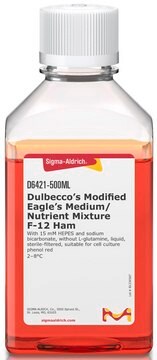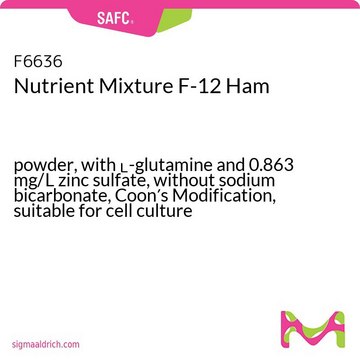推薦產品
product name
杜氏改良Eagle 培养基/营养混合物 F-12 Ham, With L-glutamine and 15 mM HEPES, without sodium bicarbonate and phenol red, powder, suitable for cell culture
品質等級
形狀
powder
技術
cell culture | mammalian: suitable
成分
NaHCO3: no
L-glutamine: yes
phenol red: no
sodium pyruvate: 0.055 g/L
glucose: 3.15 g/L
HEPES: 15 mM
運輸包裝
ambient
儲存溫度
2-8°C
尋找類似的產品? 前往 產品比較指南
一般說明
Dulbecco改良Eagle培养基/Ham F-12营养混合物适合低血清条件下广泛的细胞类型生长。克隆和干细胞培养的研究者通常更喜欢去除酚红。
應用
Dulbecco改良Eagle培养基/Ham F-12营养混合物已用于培养:
- Hep-2细胞
- 小鼠成纤维L‐细胞
- L‐ Wnt家族成员3A(Wnt3a)细胞
- 原代水牛胚胎成纤维细胞(BEF)
數量
配方中每升培养基含有15.6克的粉末。
重構
并补充1.2 g/L碳酸氢钠。
也與該產品經常一起購買
產品號碼
描述
訂價
儲存類別代碼
11 - Combustible Solids
水污染物質分類(WGK)
WGK 1
分析證明 (COA)
輸入產品批次/批號來搜索 分析證明 (COA)。在產品’s標籤上找到批次和批號,寫有 ‘Lot’或‘Batch’.。
客戶也查看了
Md Nurul Huda Bhuiyan et al.
Ecotoxicology and environmental safety, 180, 326-332 (2019-05-18)
Aniline and aniline derivatives have been widely used in the production of pesticides, pharmaceuticals, cosmetic, dyes, rubber, and adhesives products. These chemicals can easily be released into the environment through industrial and municipal discharges or as degradation byproducts. Several studies
C Zhang et al.
Osteoarthritis and cartilage, 26(6), 824-833 (2018-03-20)
Adipokines play roles in the pathogenesis of osteoarthritis (OA). Fatty acid binding protein 4 (FABP4) is a novel adipokine that is closely associated with obesity and metabolic diseases. The aim of this study was to discover the potential role of
Eric M Erkenbrack et al.
PLoS biology, 16(8), e2005594-e2005594 (2018-08-25)
Among animal species, cell types vary greatly in terms of number and kind. The number of cell types found within an organism differs considerably between species, and cell type diversity is a significant contributor to differences in organismal structure and
Tao Fu et al.
FEBS letters, 593(15), 2040-2050 (2019-06-04)
Oncostatin M (OSM) is a member of the interleukin-6 (IL-6) family, which functions in embryo implantation and decidualization. The expression, function and regulation of Osm in mouse uteri during early pregnancy remain unknown. We show that Osm is mainly expressed
Nereo Kalebic et al.
EMBO reports, 17(3), 338-348 (2016-01-14)
We have applied the CRISPR/Cas9 system in vivo to disrupt gene expression in neural stem cells in the developing mammalian brain. Two days after in utero electroporation of a single plasmid encoding Cas9 and an appropriate guide RNA (gRNA) into
我們的科學家團隊在所有研究領域都有豐富的經驗,包括生命科學、材料科學、化學合成、色譜、分析等.
聯絡技術服務






